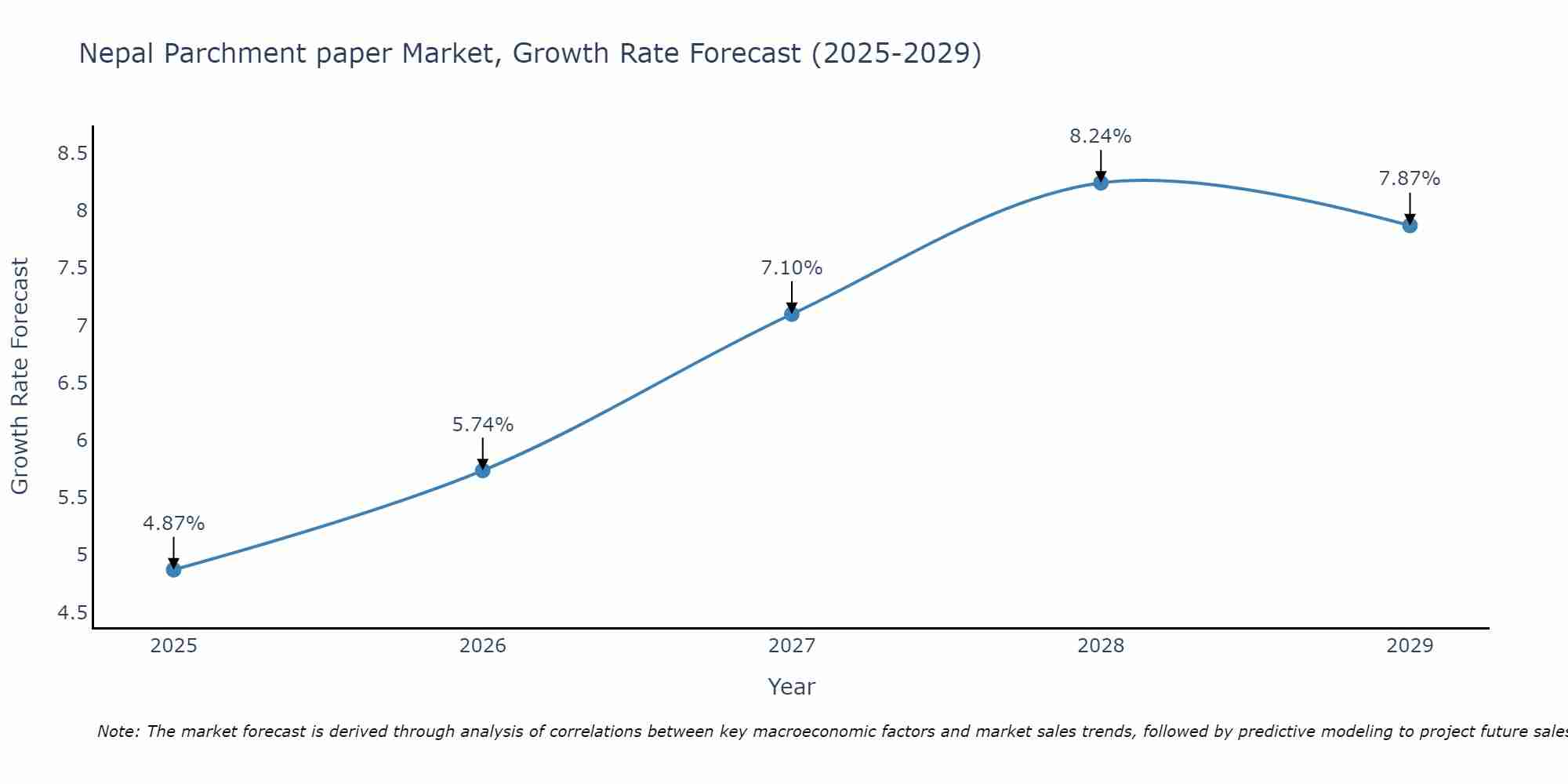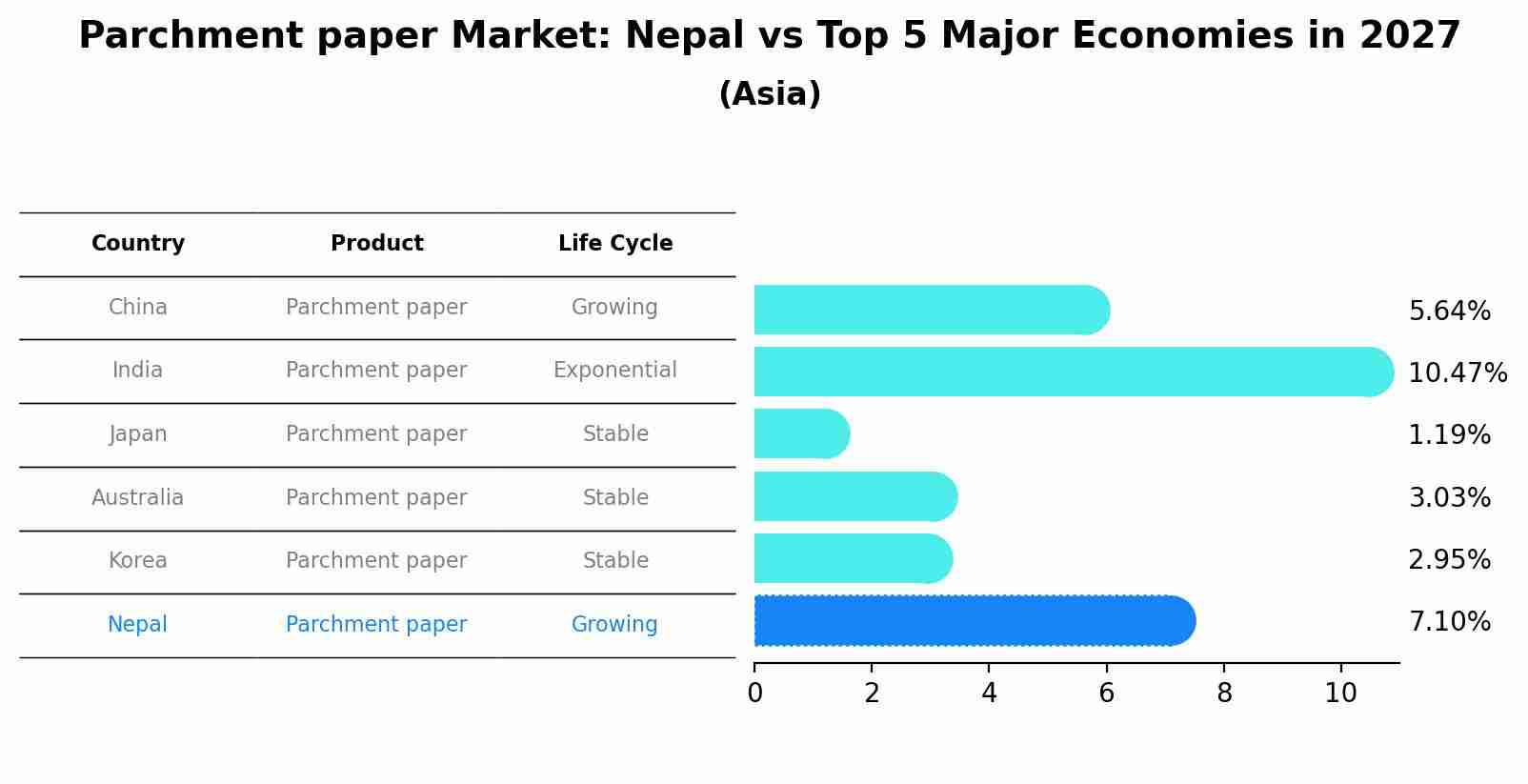Nepal Parchment paper Market (2025-2031) Outlook | Companies, Forecast, Value, Analysis, Share, Industry, Size, Growth, Revenue & Trends
| Product Code: ETC104095 | Publication Date: Jun 2021 | Updated Date: Jun 2025 | Product Type: Report | |
| Publisher: 6Wresearch | Author: Bhawna Singh | No. of Pages: 70 | No. of Figures: 35 | No. of Tables: 5 |
Nepal Parchment paper Market Size Growth Rate
The Nepal Parchment paper Market is projected to witness mixed growth rate patterns during 2025 to 2029. The growth rate begins at 4.87% in 2025, climbs to a high of 8.24% in 2028, and moderates to 7.87% by 2029.

Parchment paper Market: Nepal vs Top 5 Major Economies in 2027 (Asia)
Nepal's Parchment paper market is anticipated to experience a growing growth rate of 7.10% by 2027, reflecting trends observed in the largest economy China, followed by India, Japan, Australia and South Korea.

Nepal Parchment paper Market Overview
The Nepal parchment paper market is witnessing steady growth driven by the rising demand for eco-friendly and sustainable packaging solutions. Parchment paper, known for its non-stick and heat-resistant properties, is increasingly being used in baking, cooking, and packaging applications. The market is characterized by the presence of both domestic manufacturers and imported products from countries like India and China. Key factors contributing to market growth include the growing foodservice industry, increasing awareness about food safety and hygiene, and the trend towards convenient and ready-to-eat foods. As consumers become more health-conscious and environmentally aware, the demand for parchment paper is expected to continue to rise, presenting opportunities for both local and international players to expand their presence in the Nepal market.
Nepal Parchment paper Market Trends
The Nepal parchment paper market is witnessing a growing demand due to the increasing popularity of baking and cooking among consumers. The trend towards eco-friendly and sustainable packaging materials has also contributed to the rise in demand for parchment paper. Additionally, the hospitality industry`s focus on presentation and food safety standards has led to a higher adoption of parchment paper for food wrapping and cooking purposes. Manufacturers are responding to these trends by introducing innovative and premium quality parchment paper products to cater to the evolving needs of consumers. Overall, the Nepal parchment paper market is expected to continue its growth trajectory driven by these consumer preferences and industry demands.
Nepal Parchment paper Market Challenges
In the Nepal Parchment paper market, some challenges include limited awareness and adoption of parchment paper among consumers and businesses due to traditional cooking methods prevalent in the country. Another challenge is the inconsistent quality and availability of locally produced parchment paper, leading to reliance on imported products which can be costly. Additionally, the lack of standardized regulations and quality control measures in the industry can result in varying product quality and customer satisfaction issues. The limited distribution channels and access to modern packaging technologies also hinder the growth of the parchment paper market in Nepal. Overall, addressing these challenges through increased awareness, improved local production capabilities, and regulatory measures can help boost the market for parchment paper in the country.
Nepal Parchment paper Market Investment Opportunities
The Nepal parchment paper market presents promising investment opportunities due to the growing demand for eco-friendly and sustainable packaging solutions. With increasing awareness about environmental conservation and regulations on single-use plastics, there is a rising preference for parchment paper as an alternative packaging material in the food and beverage industry. Investing in the production and distribution of high-quality parchment paper products in Nepal can be lucrative, especially targeting local businesses and exporters looking for environmentally friendly packaging solutions. Additionally, exploring innovative applications of parchment paper, such as in the cosmetics or pharmaceutical industries, can further expand market opportunities and attract potential investors seeking sustainable ventures in Nepal`s growing market.
Nepal Parchment paper Market Government Policy
The Nepal government has implemented policies to support the parchment paper market, aiming to promote sustainable practices and enhance the quality of products. These policies include providing subsidies for farmers to adopt eco-friendly processing methods, promoting research and development initiatives for improving parchment paper production techniques, and enforcing regulations to ensure compliance with environmental standards. Additionally, the government has established partnerships with industry stakeholders to drive innovation and create market opportunities for Nepalese parchment paper products both domestically and internationally. Overall, these policies are designed to stimulate growth in the parchment paper market, encourage sustainable practices, and position Nepal as a competitive player in the global market.
Nepal Parchment paper Market Future Outlook
The future outlook for the Nepal parchment paper market appears promising due to increasing demand from various industries such as food and beverage, pharmaceuticals, and cosmetics. The growing emphasis on sustainable and eco-friendly packaging solutions is expected to drive the adoption of parchment paper in the country. Additionally, the rise in online shopping and delivery services is likely to boost the usage of parchment paper for packaging purposes. With advancements in technology and manufacturing processes, the quality and versatility of parchment paper are improving, further contributing to market growth. However, challenges such as fluctuating raw material prices and competition from alternative packaging materials may impact the market dynamics. Overall, the Nepal parchment paper market is anticipated to experience steady growth in the coming years.
Key Highlights of the Report:
- Nepal Parchment paper Market Outlook
- Market Size of Nepal Parchment paper Market, 2021
- Forecast of Nepal Parchment paper Market, 2031
- Historical Data and Forecast of Nepal Parchment paper Revenues & Volume for the Period 2021 - 2031
- Nepal Parchment paper Market Trend Evolution
- Nepal Parchment paper Market Drivers and Challenges
- Nepal Parchment paper Price Trends
- Nepal Parchment paper Porter's Five Forces
- Nepal Parchment paper Industry Life Cycle
- Historical Data and Forecast of Nepal Parchment paper Market Revenues & Volume By Paper Grades for the Period 2021 - 2031
- Historical Data and Forecast of Nepal Parchment paper Market Revenues & Volume By Bleached for the Period 2021 - 2031
- Historical Data and Forecast of Nepal Parchment paper Market Revenues & Volume By Natural for the Period 2021 - 2031
- Historical Data and Forecast of Nepal Parchment paper Market Revenues & Volume By Resin Treated for the Period 2021 - 2031
- Historical Data and Forecast of Nepal Parchment paper Market Revenues & Volume By Others for the Period 2021 - 2031
- Historical Data and Forecast of Nepal Parchment paper Market Revenues & Volume By End-use for the Period 2021 - 2031
- Historical Data and Forecast of Nepal Parchment paper Market Revenues & Volume By Seafood for the Period 2021 - 2031
- Historical Data and Forecast of Nepal Parchment paper Market Revenues & Volume By Chicken for the Period 2021 - 2031
- Historical Data and Forecast of Nepal Parchment paper Market Revenues & Volume By Vegetables for the Period 2021 - 2031
- Historical Data and Forecast of Nepal Parchment paper Market Revenues & Volume By Others for the Period 2021 - 2031
- Nepal Parchment paper Import Export Trade Statistics
- Market Opportunity Assessment By Paper Grades
- Market Opportunity Assessment By End-use
- Nepal Parchment paper Top Companies Market Share
- Nepal Parchment paper Competitive Benchmarking By Technical and Operational Parameters
- Nepal Parchment paper Company Profiles
- Nepal Parchment paper Key Strategic Recommendations
Frequently Asked Questions About the Market Study (FAQs):
- Single User License$ 1,995
- Department License$ 2,400
- Site License$ 3,120
- Global License$ 3,795
Search
Related Reports
- ASEAN Bearings Market (2025-2031) | Strategy, Consumer Insights, Analysis, Investment Trends, Opportunities, Growth, Size, Share, Industry, Revenue, Segments, Value, Segmentation, Supply, Forecast, Restraints, Outlook, Competition, Drivers, Trends, Demand, Pricing Analysis, Competitive, Strategic Insights, Companies, Challenges
- Europe Flooring Market (2025-2031) | Outlook, Share, Industry, Trends, Forecast, Companies, Revenue, Size, Analysis, Growth & Value
- Saudi Arabia Manlift Market (2025-2031) | Outlook, Size, Growth, Trends, Companies, Industry, Revenue, Value, Share, Forecast & Analysis
- Uganda Excavator, Crane, and Wheel Loaders Market (2025-2031) | Strategy, Consumer Insights, Analysis, Investment Trends, Opportunities, Growth, Size, Share, Industry, Revenue, Segments, Value, Segmentation, Supply, Forecast, Restraints, Outlook, Competition, Drivers, Trends, Demand, Pricing Analysis, Competitive, Strategic Insights, Companies, Challenges
- Rwanda Excavator, Crane, and Wheel Loaders Market (2025-2031) | Strategy, Consumer Insights, Analysis, Investment Trends, Opportunities, Growth, Size, Share, Industry, Revenue, Segments, Value, Segmentation, Supply, Forecast, Restraints, Outlook, Competition, Drivers, Trends, Demand, Pricing Analysis, Competitive, Strategic Insights, Companies, Challenges
- Kenya Excavator, Crane, and Wheel Loaders Market (2025-2031) | Strategy, Consumer Insights, Analysis, Investment Trends, Opportunities, Growth, Size, Share, Industry, Revenue, Segments, Value, Segmentation, Supply, Forecast, Restraints, Outlook, Competition, Drivers, Trends, Demand, Pricing Analysis, Competitive, Strategic Insights, Companies, Challenges
- Angola Excavator, Crane, and Wheel Loaders Market (2025-2031) | Strategy, Consumer Insights, Analysis, Investment Trends, Opportunities, Growth, Size, Share, Industry, Revenue, Segments, Value, Segmentation, Supply, Forecast, Restraints, Outlook, Competition, Drivers, Trends, Demand, Pricing Analysis, Competitive, Strategic Insights, Companies, Challenges
- Israel Intelligent Transport System Market (2025-2031) | Strategy, Consumer Insights, Analysis, Investment Trends, Opportunities, Growth, Size, Share, Industry, Revenue, Segments, Value, Segmentation, Supply, Forecast, Restraints, Outlook, Competition, Drivers, Trends, Demand, Pricing Analysis, Competitive, Strategic Insights, Companies, Challenges
- Uganda Precast and Aggregate Market (2025-2031) | Strategy, Consumer Insights, Analysis, Investment Trends, Opportunities, Growth, Size, Share, Industry, Revenue, Segments, Value, Segmentation, Supply, Forecast, Restraints, Outlook, Competition, Drivers, Trends, Demand, Pricing Analysis, Competitive, Strategic Insights, Companies, Challenges
- Australia IT Asset Disposal Market (2025-2031) | Strategy, Consumer Insights, Analysis, Investment Trends, Opportunities, Growth, Size, Share, Industry, Revenue, Segments, Value, Segmentation, Supply, Forecast, Restraints, Outlook, Competition, Drivers, Trends, Demand, Pricing Analysis, Competitive, Strategic Insights, Companies, Challenges
Industry Events and Analyst Meet
Our Clients
Whitepaper
- Middle East & Africa Commercial Security Market Click here to view more.
- Middle East & Africa Fire Safety Systems & Equipment Market Click here to view more.
- GCC Drone Market Click here to view more.
- Middle East Lighting Fixture Market Click here to view more.
- GCC Physical & Perimeter Security Market Click here to view more.
6WResearch In News
- Doha a strategic location for EV manufacturing hub: IPA Qatar
- Demand for luxury TVs surging in the GCC, says Samsung
- Empowering Growth: The Thriving Journey of Bangladesh’s Cable Industry
- Demand for luxury TVs surging in the GCC, says Samsung
- Video call with a traditional healer? Once unthinkable, it’s now common in South Africa
- Intelligent Buildings To Smooth GCC’s Path To Net Zero













